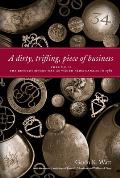

|
 |
|
This article on Loyalist families is presented in 8 parts. Click below to skip to:
Part 1 - Introduction |
Female Ancestors |
|
Problems in Camp While the services of these women in camp was a definite benefit to the regiment and army, it was not without its downside as well. Sometimes the combination of family life and the military were incompatible or caused disruptions. One problem was taking away good soldiers from their military duties to better look after a large family. In the case of the King's Loyal Americans serving at Sorel in October of 1778, ten men out of a strength of only 86 survivors of the Burgoyne Campaign had to be left at Quebec and Montreal to tend to their families.29 Sometimes the needs of the family came before the army, as in the case of Christian PULISVELDT, a Bergen County, N.J. Loyalist. He served as a private in the 4th Battalion, New Jersey Volunteers in 1777, a time when no provision was made for all families. Unable to support a family consisting of a wife and five children, he was able to obtain a discharge from the regiment and seek employment in the Commissary General's Department, which also proved inadequate to his needs. Making a marginal living as a basket maker, he was forced to seek provisions for himself and family as destitute refugees in 1782.30 Leaving behind a small detachment to look after the families while the regiment campaigned far away has been briefly discussed earlier. That, too, was not without its problems. Joshua HAMILTON, an assistant in the Inspector General of Provincial Forces Department, sailed with the fleet to capture Charlestown in December of 1779. Before leaving, he made arrangements for his wife Elizabeth to receive three dollars per week out of his salary, as well as insuring that she and his two children would receive provisions, fuel and quarters. He was unfortunately taken by a Rebel privateer on his voyage and held a prisoner for fourteen months. What he found waiting for him at New York was not exactly a teary eyed homecoming: ...having late obtained my parole I returned to New-York, where, upon my arrival I found to my great astonishment, that my said wife had during my absence become a common prostitute to both soldiers and sailors, and that on the 23d day of October last, she was married by the Reverend Mr. WALTER, Chaplain to the third battalion of Brig. Gen. DeLancey's brigade, to one John POFF, a Hessian soldier, in the battalion of Landgrave a certificate of which marriage now remains in my hands.31 Not all the women in camp were exactly of the best sort. Thomas POWERS, a private in the Volunteers of Ireland in 1778, fatally learned how dangerous some of the women could be. He was on guard duty in the quarters of the regimental tailors when Lucretia ELLIS the wife ("the appellation that [she] generally went by") of Archibald McNICOLL smashed a heavy bottle into his ribs while her "husband" stabbed him with a bayonet. It seems they had taken exception to their confinement for being drunk (which by-the-bye, POWERS was also). He died soon afterwards but amazingly neither of them was convicted of murder.32 Being with the regiments in garrison or on campaign was attendant with all the dangers of a military life. Samuel BURKE, a free black native of Charlestown, S.C. and servant to General Montfort BROWNE (as well as a soldier) in the Prince of Wales American Volunteers, proudly boasted his wife "a free Dutch mullato Woman" with "a very Good House and Garden situate in New York, with Furniture" had "accompanyed him in all his marches & routes- during upwards of eight years hard Service in America."33 Women and children often saw the real face of war, often with severe consequences. Lieutenant and Adjutant James MILLER of the Maryland Loyalists set sail with his family to recover from a wound, only to be captured and ransomed by the Rebel privateer New Black Princess off the coast of Ireland in May of 1781.34 Sometimes the war would come to them. The women and children of the 4th Battalion, New Jersey Volunteers and the Garrison Battalion witnessed the terrible assault on Paulus Hook by Lt. Col. Henry Lee and a force of continental troops in August of 1779. Lee would later excuse his not burning the barracks due to the great number of dependents there. Others witnessed the death or capture of their loved ones first hand. Thomas Tredwell JACKSON describes his experience in capturing the Loyalist post of Fort St. George, Long Island, on the 23rd of November 1780: The poor dogs had not time to rub their eyes, or gasp before they were obliged to cry Quarters. A musical sound. Here was a scene my friend, of war my eyes never beheld nor description cannot equal. The cries of the wounded in the agonies of death. The screeching of the women and children while the parent and friend were entreating pity and compassion, called forth every tender feeling, yet add to these the shouts of the veterans it gives a pleasing lustre to the triumphs of a soldier.35 These encounters rarely targeted the dependents, but there were the exceptions. One tragic incident occurred during Sullivan's attack on Staten Island on 22 August 1777. The garrison, composed to a great degree of New Jersey Volunteers, was engaged all over the island. The third battalion of this corps of six was retreating towards some old rebel works, led by their twenty eight year old commander, Lt. Col. Edward Vaughan DONGAN. His wife and children, not thinking themselves in danger, did not flee with the corps. When Sullivan's attack broke down into a plundering expedition, some Continentals made Mrs. DONGAN an object of their desire, chasing her through woods and swamps, her three year old child at her side. At the same time she was being abused, her husband was shot and mortally wounded in a counterattack elsewhere on the island. He would die three days later. The shock of witnessing his mother's abuse and his father's wound caused the death of their child, only a few hours before the colonel's. They were buried together in Trinity Church, New York.36
29 Muster Rolls of the King's Loyal Americans, Sorel, 16 October 1778. PRO, War Office Papers, Class 28, Volume 4, folios 84-89.
Click here for ---> Female Ancestors Main Page Refugees & Others: Loyalist Families
The On-Line Institute for Advanced Loyalist Studies Copyright Restrictions Document Formatting Optimal Viewing |
 by Angela Elwell HuntHardcover
by Angela Elwell HuntHardcover